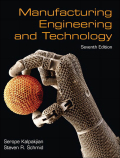
EBK MANUFACTURING ENGINEERING & TECHNOL
7th Edition
ISBN: 8220100793431
Author: KALPAKJIAN
Publisher: PEARSON
expand_more
expand_more
format_list_bulleted
Concept explainers
Textbook Question
Chapter 6, Problem 4RQ
What are superalloys? Why are they so named?
Expert Solution & Answer
Want to see the full answer?
Check out a sample textbook solution
Students have asked these similar questions
PROBLEM 3.23
3.23 Under normal operating condi-
tions a motor exerts a torque of
magnitude TF at F. The shafts
are made of a steel for which
the allowable shearing stress is
82 MPa and have diameters of
dCDE=24 mm and dFGH = 20
mm. Knowing that rp = 165
mm and rg114 mm, deter-
mine the largest torque TF
which may be exerted at F.
TF
F
rG-
rp
B
CH
TE
E
1. (16%) (a) If a ductile material fails under pure torsion, please explain the failure
mode and describe the observed plane of failure.
(b) Suppose a prismatic beam is subjected to equal and opposite couples as shown
in Fig. 1. Please sketch the deformation and the stress distribution of the cross
section.
M
M
Fig. 1
(c) Describe the definition of the neutral axis.
(d) Describe the definition of the modular ratio.
using the theorem of three moments, find all the moments, I only need concise calculations with minimal explanations. The correct answers are provided at the bottom
Chapter 6 Solutions
EBK MANUFACTURING ENGINEERING & TECHNOL
Ch. 6 - Given the abundance of aluminum in the Earths...Ch. 6 - Prob. 2RQCh. 6 - What are the major uses of copper? What arc the...Ch. 6 - What are superalloys? Why are they so named?Ch. 6 - What properties of titanium make it attractive for...Ch. 6 - Which properties of each of the major refractory...Ch. 6 - Prob. 7RQCh. 6 - What it the composition of (a) babbitts, (b)...Ch. 6 - Name the materials described in this chapter that...Ch. 6 - What are the major uses of gold and silver, other...
Ch. 6 - Describe the advantages to using zinc as a coating...Ch. 6 - Prob. 12RQCh. 6 - Why are aircraft fuselages made of aluminum...Ch. 6 - How is metal foam produced?Ch. 6 - What metals have the lowest melting points? What...Ch. 6 - Explain why cooking utensils generally are made of...Ch. 6 - Would it be advantageous to plot the data in Table...Ch. 6 - Compare the contents of Table 6.3 with those in...Ch. 6 - What factors other than mechanical strength should...Ch. 6 - Prob. 20QLPCh. 6 - If aircraft, such as a Boeing 757, are made of 79%...Ch. 6 - Prob. 22QLPCh. 6 - Most household wiring is made of copper wire. By...Ch. 6 - The example in this chapter showed the benefits of...Ch. 6 - If tungsten is the highest melting-point metal,...Ch. 6 - A simply supported rectangular beam is 25 mm wide...Ch. 6 - Obtain a few aluminum beverage cans, cut them, and...Ch. 6 - Beverage cans usually are stacked on top of each...Ch. 6 - Using strength and density data, determine the...Ch. 6 - Plot the following for the materials described in...Ch. 6 - Prob. 33SDPCh. 6 - Give some applications for (a) amorphous metals,...Ch. 6 - Describe the advantages of making products with...Ch. 6 - In the text, magnesium was described as the...Ch. 6 - Prob. 38SDPCh. 6 - Review the technical literature, and write a...
Knowledge Booster
Learn more about
Need a deep-dive on the concept behind this application? Look no further. Learn more about this topic, mechanical-engineering and related others by exploring similar questions and additional content below.Similar questions
- PROBLEM 3.46 The solid cylindrical rod BC of length L = 600 mm is attached to the rigid lever AB of length a = 380 mm and to the support at C. When a 500 N force P is applied at A, design specifications require that the displacement of A not exceed 25 mm when a 500 N force P is applied at A For the material indicated determine the required diameter of the rod. Aluminium: Tall = 65 MPa, G = 27 GPa. Aarrow_forwardFind the equivalent mass of the rocker arm assembly with respect to the x coordinate. k₁ mi m2 k₁arrow_forward2. Figure below shows a U-tube manometer open at both ends and containing a column of liquid mercury of length l and specific weight y. Considering a small displacement x of the manometer meniscus from its equilibrium position (or datum), determine the equivalent spring constant associated with the restoring force. Datum Area, Aarrow_forward
- 1. The consequences of a head-on collision of two automobiles can be studied by considering the impact of the automobile on a barrier, as shown in figure below. Construct a mathematical model (i.e., draw the diagram) by considering the masses of the automobile body, engine, transmission, and suspension and the elasticity of the bumpers, radiator, sheet metal body, driveline, and engine mounts.arrow_forward3.) 15.40 – Collar B moves up at constant velocity vB = 1.5 m/s. Rod AB has length = 1.2 m. The incline is at angle = 25°. Compute an expression for the angular velocity of rod AB, ė and the velocity of end A of the rod (✓✓) as a function of v₂,1,0,0. Then compute numerical answers for ȧ & y_ with 0 = 50°.arrow_forward2.) 15.12 The assembly shown consists of the straight rod ABC which passes through and is welded to the grectangular plate DEFH. The assembly rotates about the axis AC with a constant angular velocity of 9 rad/s. Knowing that the motion when viewed from C is counterclockwise, determine the velocity and acceleration of corner F.arrow_forward
arrow_back_ios
SEE MORE QUESTIONS
arrow_forward_ios
Recommended textbooks for you
 Welding: Principles and Applications (MindTap Cou...Mechanical EngineeringISBN:9781305494695Author:Larry JeffusPublisher:Cengage Learning
Welding: Principles and Applications (MindTap Cou...Mechanical EngineeringISBN:9781305494695Author:Larry JeffusPublisher:Cengage Learning

Welding: Principles and Applications (MindTap Cou...
Mechanical Engineering
ISBN:9781305494695
Author:Larry Jeffus
Publisher:Cengage Learning
How to Measure Threads; Author: PracticalMachinist;https://www.youtube.com/watch?v=Uuy7EViS7Kc;License: Standard Youtube License